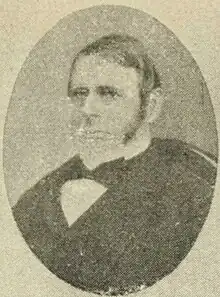William Kerley Strong | |
|---|---|
 | |
| Born | April 30, 1805 Duanesburg, New York |
| Died | March 16, 1867 (aged 61) New York |
| Allegiance | United States of America |
| Service/ | Union Army |
| Years of service | 1861–1863 |
| Rank | |
| Commands held | Distric of Cairo District of St. Louis |
| Battles/wars | American Civil War |
| Spouse(s) | Helen Mary Hart |
| Children | John Lorimer |
| Other work | merchant |
William Kerley Strong (1805–1867) was a merchant and a brigadier general during the American Civil War. He was the commander of Benton Barracks and the districts of Cairo and St. Louis. Strong was also a prominent Democrat, noted his pro-Union speeches.[1]
Biography
Strong was a wealthy wool merchant in New York.[1] He was born on April 30, 1805, in Duanesburg, New York[2] to Josiah Strong and Martha Green.[3] Strong's father was an American Revolutionary War veteran who had fought in the Battle of Trenton under George Washington.[3]
Strong was married to Helen Mary Hart and they had 9 children, among whom John Lorimer, and Helen Hart, spouse of Henry Piffard.
.jpg.webp)
In 1839, Strong was noted for constructing a sprawling grand mansion covering 11,634 feet of living space.[5] The property called Rose Hill Mansion was given to Robert Swan in 1850.[4] A contemporaneous newspaper report cited that the property, which was designated a national historic landmark, was sold to Swan's father, who gave it to him as a wedding present.[6]
Strong died on March 16, 1867.[7] He never recovered from his injuries after he was thrown out of his carriage.[7]
Civil War
When the American Civil War began, Strong was travelling around Egypt. He helped the Union cause by securing weapons in France on his way home.[1] An account cited that because of his pro-Union speeches, he gained the attention of Abraham Lincoln, who appointed him as brigadier general.[1][7] He was not assigned to field duty but made commander of the Benton Barracks in Missouri.[7] In 1862, he was appointed commander of the District of Cairo, Illinois, replacing General Eleazar A. Paine, who was reassigned for violating orders.[8] Strong was sent to New York for an unknown mission before he was appointed the commander of the District of St. Louis from June to October 1863.[1] He resigned his commission on October 20.
Strong was also appointed as the president of a commission that investigated the circumstances behind the evacuation of the Union forces in New Madrid, Missouri.[7]
After the war, he settled in New York and started employing Black workers.
References
- 1 2 3 4 5 Jones, Terry L. (2002). Historical Dictionary of the Civil War, Volume 1. Lanham, Maryland: Scarecrow Press. p. 1381. ISBN 0-8108-4112-6.
- ↑ Eicher, John; Eicher, David (2002). Civil War High Commands. Stanford, CA: Stanford University Press. p. 517. ISBN 978-0-8047-8035-3.
- 1 2 Dwight, Benjamin W. (1871). The history of the descendants of Elder John Strong, of Northampton, Mass. Dalcassian Publishing Company. p. 1422.
- 1 2 Williams, Deborah (2009). Explorer's Guide Erie Canal: A Great Destination: Exploring New York's Great Canals. Woodstock, VT: The Countryman Press. p. 137. ISBN 978-1-58157-080-9.
- ↑ "William Kerley Strong". Asbury Park Press. 2002-09-29. p. 97. Retrieved 2021-02-12.
- ↑ "1 Jul 1986, Page 9 - Democrat and Chronicle at Newspapers.com". Newspapers.com. Retrieved 2021-02-15.
- 1 2 3 4 5 Hannings, Bud (2010). Every Day of the Civil War: A Chronological Encyclopedia. Jefferson, NC: McFarland. p. 87. ISBN 978-0-7864-4464-9.
- ↑ "Henry W. Halleck to Brigadier General George W. Cullum, Cairo regarding Genl. William K. Strong and Genl. Paine - American History 1493-1945 - Adam Matthew Digital". www.americanhistory.amdigital.co.uk. Retrieved 2021-02-22.